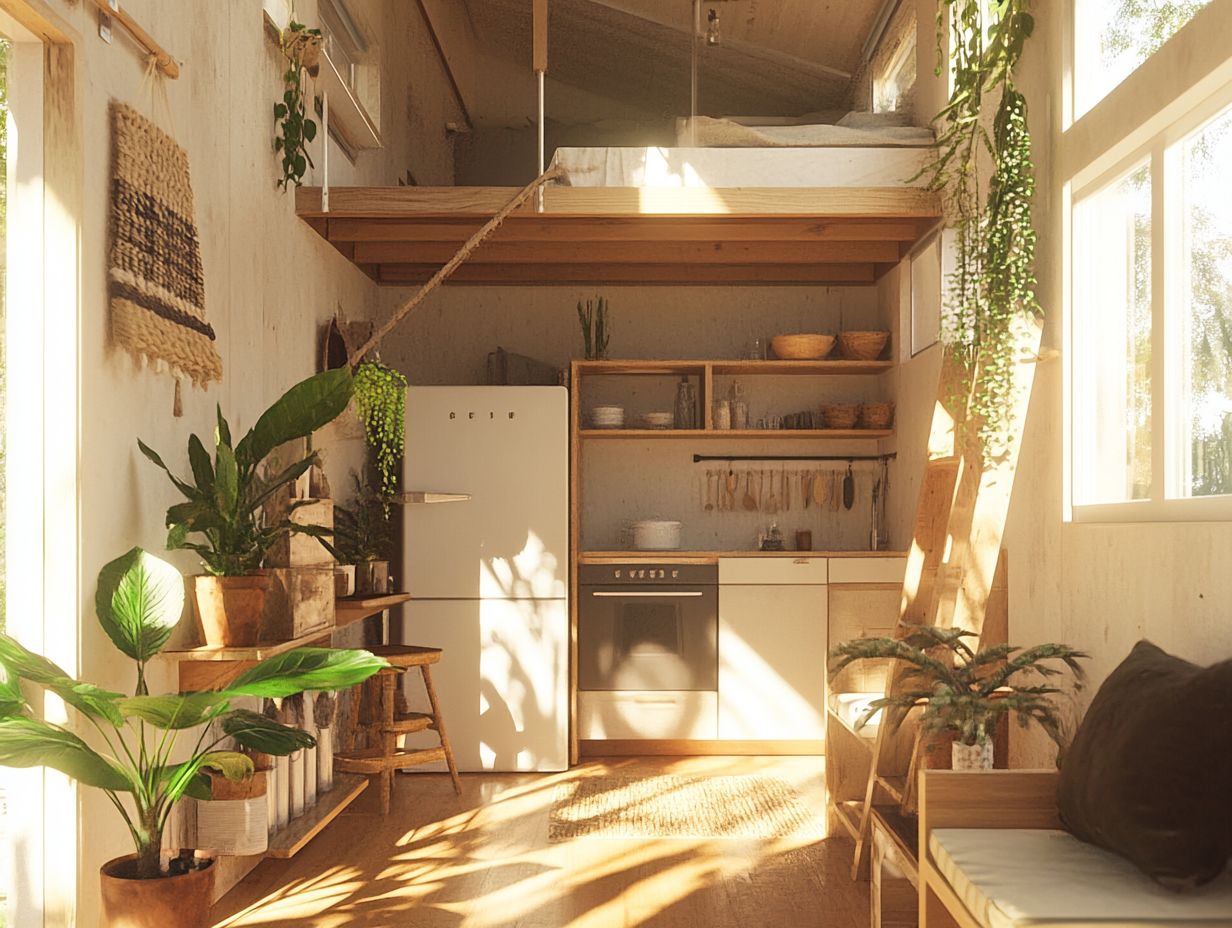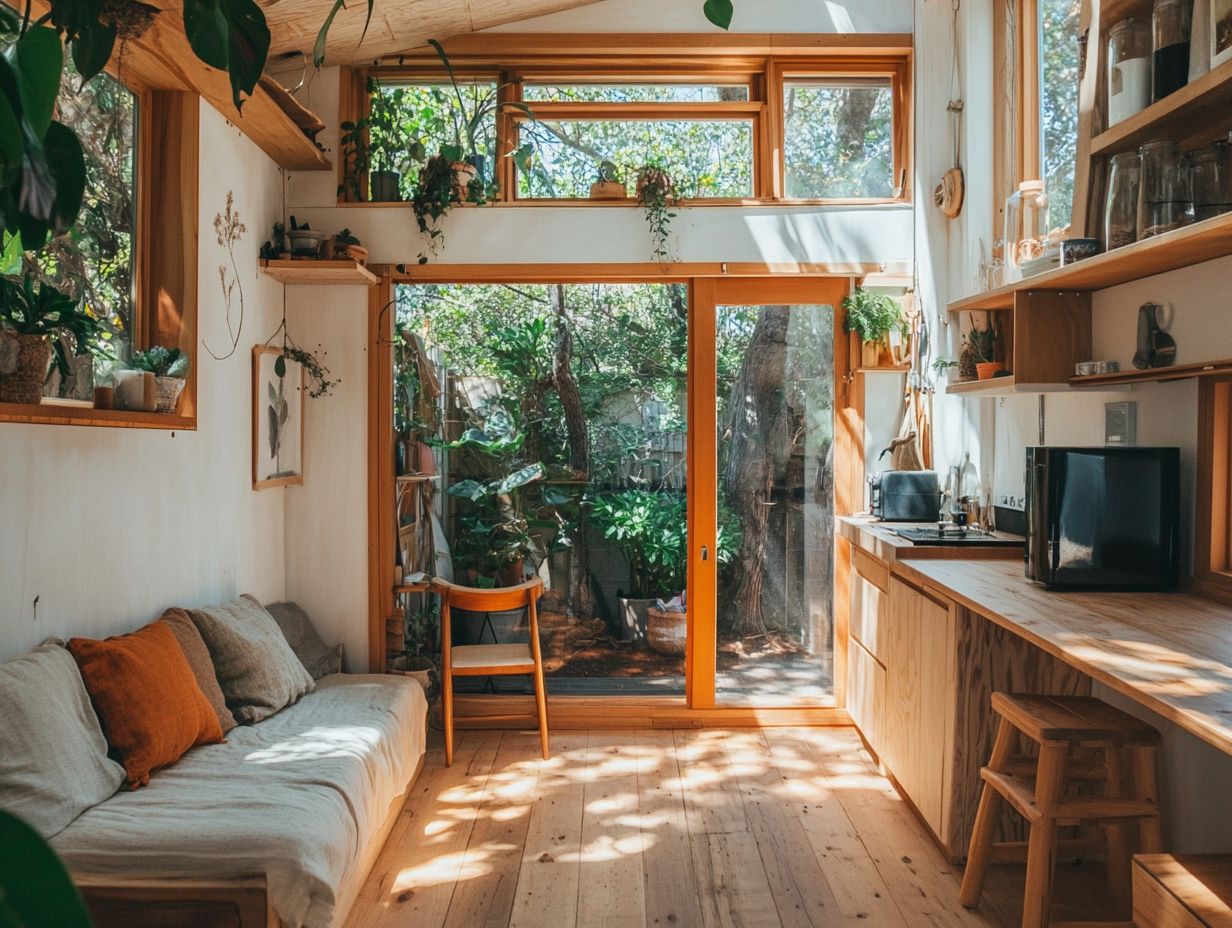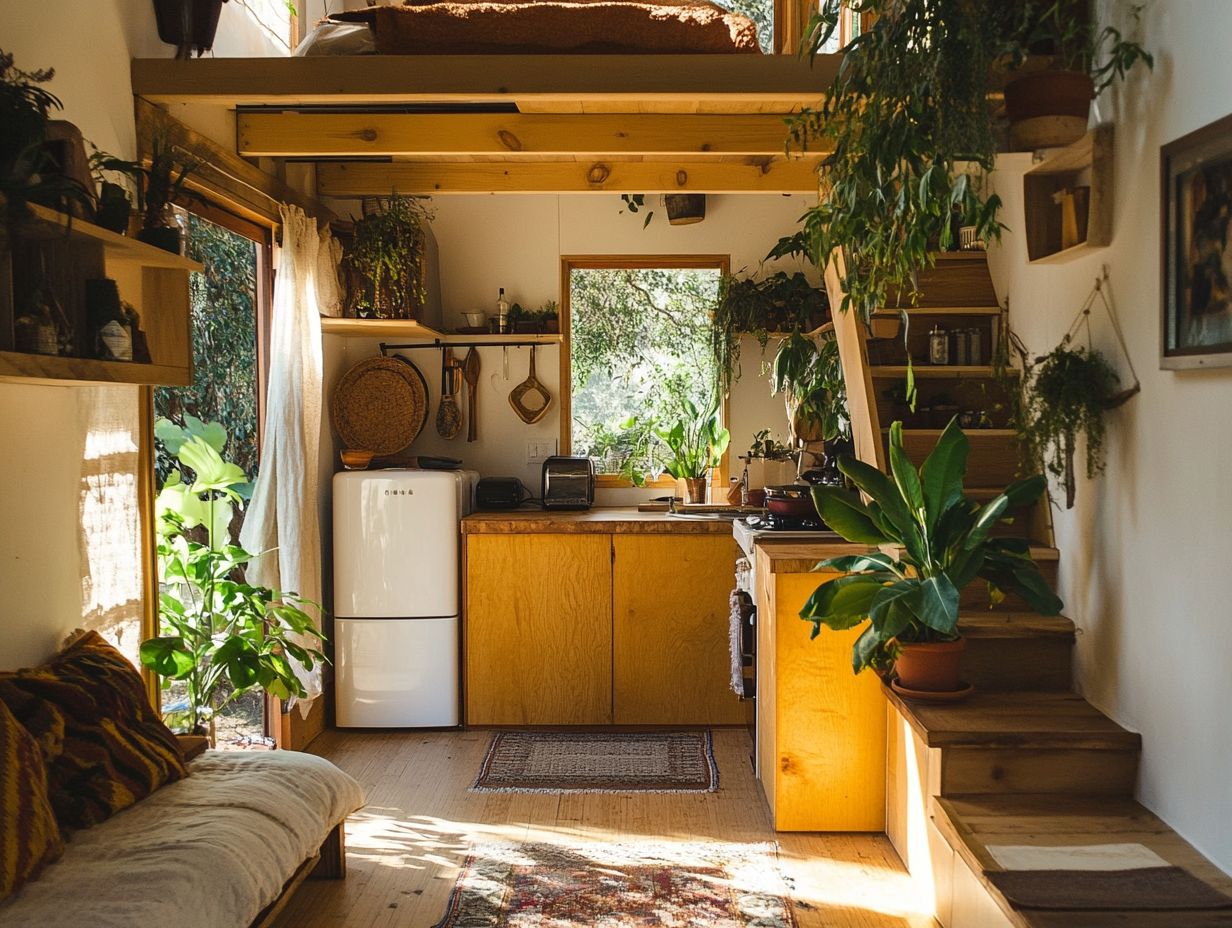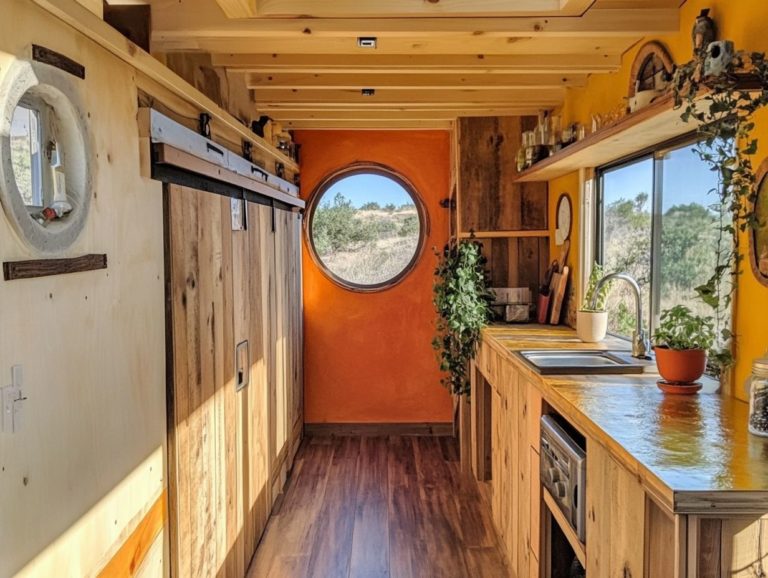How to Care for Sustainable Materials in Tiny Houses
In a world that s increasingly prioritizing sustainability, tiny houses emerge as a remarkable fusion of eco-friendliness and minimalist living.
Let’s dive into the crucial role sustainable materials play in tiny house construction and design, showcasing their environmental benefits and potential cost savings.
You ll gain essential maintenance tips to ensure longevity, along with an overview of the most popular sustainable materials in use today.
The discussion will also cover future innovations in sustainable materials, providing you with a sneak peek into what lies ahead.
Join the movement towards greener living today!
Contents [hide]
- Key Takeaways:
- Benefits of Using Sustainable Materials in Tiny Houses
- Caring for Sustainable Materials
- Maintenance and Preservation Tips
- Common Sustainable Materials Used in Tiny Houses
- Overview and Characteristics
- Incorporating Sustainable Materials into Tiny House Design
- Practical and Aesthetic Considerations
- Future of Sustainable Materials in Tiny Houses
- Frequently Asked Questions
- What are some sustainable materials commonly used in tiny houses?
- How can I maintain and care for the sustainable materials in my tiny house?
- What steps can I take to ensure the longevity of sustainable materials in my tiny house?
- Are there any specific cleaning or maintenance guidelines for different types of sustainable materials?
- How can I incorporate sustainable materials into my tiny house design?
- What are the benefits of using sustainable materials in tiny houses?
Key Takeaways:

- Choose sustainable materials in tiny houses to reduce environmental impact and save on costs.
- Keep your materials in top shape for longevity and continued sustainability.
- Consider practicality and aesthetics when incorporating sustainable materials into tiny house design.
What are Sustainable Materials?
Sustainable materials are your go-to environmentally friendly materials for minimizing your carbon footprint the amount of greenhouse gases produced by our activities and nurturing a healthier ecosystem, especially when it comes to constructing tiny houses.
These materials not only slash energy consumption but also embody the principles of sustainable living by incorporating recycled materials in tiny house designs, such as reclaimed wood, recycled resources, and bamboo flooring in the design of durable tiny homes that resonate with environmentally conscious practices.
By tapping into the benefits of sustainable materials, you can significantly reduce waste and emissions, contributing to a greener construction industry. Options like reclaimed wood and bamboo are not just resilient; they excel at sequestering carbon throughout their lifecycle, highlighting the role of sustainability in tiny house construction.
Choosing these materials aligns seamlessly with a minimalist lifestyle, prompting you to focus on efficiency and purpose rather than excess. This harmony between sustainable practices and minimalist living elevates your overall experience while ensuring that you make the most of available resources, paving the way for future generations to inherit a cleaner, healthier planet. To understand how these choices can influence your investment, consider the impact of sustainable materials on tiny house value.
Benefits of Using Sustainable Materials in Tiny Houses
Using sustainable materials in tiny houses offers amazing benefits, championing eco-friendly practices while delivering substantial cost savings and boosting energy efficiency.
By incorporating high-efficiency appliances and innovative insulation, you not only reduce your overall carbon footprint but also enhance the comfort and livability of your compact space. Additionally, choosing sustainable paint options for tiny house interiors makes tiny houses an ideal choice for anyone committed to a sustainable lifestyle.
Environmental Impact and Cost Savings
The environmental impact of using sustainable materials in tiny houses goes beyond aesthetics; it leads to significant reductions in energy consumption and creates a healthier living environment. By choosing eco-friendly practices and materials, you can enjoy substantial cost savings over time while making a positive contribution to the planet.
Incorporating energy-efficient designs can dramatically slash your utility bills. Features like well-insulated walls and strategically placed windows enhance natural lighting and reduce the need for artificial heating and cooling.
Using water conservation techniques, such as low-flow fixtures and greywater recycling systems, minimizes water waste and further lowers your household expenses.
By embracing these practical strategies, you gain a dual benefit: a reduced carbon footprint and lower ongoing costs. Sustainability becomes a win-win for both your finances and the environment.
Caring for Sustainable Materials

Caring for sustainable materials is crucial for ensuring their longevity and effectiveness in tiny houses. This care involves a thoughtful blend of proper maintenance and eco-friendly practices.
By employing effective cleaning techniques and preservation methods, you can significantly enhance the durability of your reclaimed and recycled materials. Additionally, consider how to choose eco-friendly flooring for tiny homes. This way, your investments not only serve you well but also continue to protect the environment for years to come.
Maintenance and Preservation Tips
Maintaining and preserving sustainable materials in your tiny house requires a keen eye for detail. This ensures that everything remains both functional and visually appealing. By embracing eco-friendly practices, you can significantly extend the lifespan of your materials while enhancing the overall sustainability of your living space.
For example, caring for bamboo flooring means regularly sweeping to eliminate dust and debris. Use a damp mop with natural cleaners to fend off moisture damage. Ensuring your energy-saving devices run smoothly is essential; this involves regularly checking seals and cleaning filters to keep them operating at peak performance. Additionally, incorporating sustainable building techniques for tiny houses can enhance the overall efficiency of your living space.
Implement a maintenance schedule to periodically check your sustainable materials. Using natural cleaning products not only aligns with your eco-friendly ideals but also safeguards the integrity of these materials, promoting a healthier environment for everyone in your tiny house. For more insights, explore sustainable design practices for tiny houses.
Common Sustainable Materials Used in Tiny Houses
Tiny houses often embrace a selection of sustainable materials that elevate their aesthetic charm while championing environmentally friendly practices. Imagine reclaimed wood, elegant bamboo flooring, and a variety of recycled materials coming together.
Each of these elements brings unique qualities, enhancing both the usefulness and sustainability of compact home designs.
Overview and Characteristics
Exploring sustainable materials reveals a captivating array of qualities that make them perfect for tiny houses. These materials highlight their eco-friendly and energy-efficient attributes. They not only reduce carbon emissions but also elevate your living experience by offering durability and comfort.
Take reclaimed wood, for instance. It brings a unique charm that whispers stories of the past while ensuring that no new trees are felled, making it a stylish yet responsible choice for your home.
Bamboo is another standout option, celebrated for its remarkable strength and rapid growth. This means you can incorporate it extensively without harming ecosystems.
Both materials work to diminish your carbon footprint, often requiring less energy for production compared to conventional building supplies. Their natural aesthetic creates a warm, inviting atmosphere that perfectly aligns with the minimalistic ethos of tiny house living. For example, reclaimed wood is a sustainable choice that enhances this lifestyle.
Incorporating Sustainable Materials into Tiny House Design

Incorporating sustainable materials into your tiny house design demands a thoughtful approach that beautifully balances aesthetic appeal with eco-friendly practices, all while maximizing space efficiency.
By strategically selecting materials such as reclaimed wood and energy-saving devices, you can craft compact designs that not only exude beauty but also embody a commitment to sustainable building materials for tiny homes.
Practical and Aesthetic Considerations
When you choose sustainable materials, practical and aesthetic considerations unite seamlessly. This decision not only caters to your functional needs but also elevates the overall beauty of your space. By integrating smart home technologies with these materials, you can curate a living environment that is both visually stunning and exceptionally functional.
For example, opting for reclaimed wood in your cabinetry can lend a rustic charm while simultaneously reducing waste, showcasing your commitment to eco-friendliness. Similarly, incorporating energy-efficient devices like smart thermostats or LED lighting minimizes energy consumption, giving you greater control over your home’s ambiance.
This harmonious blend of form and function creates an enriching living experience that aligns with the principles of modern sustainability, proving that tiny homes can indeed be stylish while being resource-conscious. For those looking to enhance their tiny home, understanding how to source sustainable materials is key.
Future of Sustainable Materials in Tiny Houses
The future of sustainable materials in tiny houses unfolds with great promise, marked by continuous advancements and innovations that elevate their environmental benefits and broaden their application. As technology evolves, you can anticipate a wider array of eco-friendly materials that not only meet but surpass the existing standards of sustainable living.
Act now to ensure your tiny house remains beautiful and eco-friendly! Stay informed about new developments in sustainable materials to keep your home at the forefront of eco-conscious design!
Advancements and Innovations
Innovations in sustainable materials are transforming tiny house construction. Eco-friendly technologies enhance both function and style.
Materials like bamboo and recycled plastics are popular due to their durability and reduced environmental impact. Incorporating smart technologies such as solar panels and energy-efficient appliances boosts tiny homes’ sustainability.
Smart thermostats optimize energy use. Modular designs improve efficiency. This blend of materials and systems not only makes tiny houses more livable but also inspires a greener living movement.
Frequently Asked Questions

What are some sustainable materials commonly used in tiny houses?
Common sustainable materials in tiny houses include reclaimed wood, bamboo, and recycled plastics. These choices are eco-friendly and often cost-effective.
How can I maintain and care for the sustainable materials in my tiny house?
To care for sustainable materials, use natural cleaning products and regularly check for wear. Avoid harsh chemicals or excessive heat.
What steps can I take to ensure the longevity of sustainable materials in my tiny house?
Ensure long-lasting materials by sealing and protecting them properly. Use them as intended and make repairs promptly.
Are there any specific cleaning or maintenance guidelines for different types of sustainable materials?
Yes, each material may need specific care. For example, reclaimed wood often requires periodic oiling, while bamboo can be cleaned with mild soap and water.
How can I incorporate sustainable materials into my tiny house design?
There are many creative ways to use sustainable materials, like salvaged flooring or recycled metal backsplashes. Research your options before starting the design process.
What are the benefits of using sustainable materials in tiny houses?
Using sustainable materials reduces environmental impact and promotes healthier indoor air quality. It can also save money on energy and maintenance in the long run.
Imagine living in a space that s not only beautiful but also eco-friendly!






